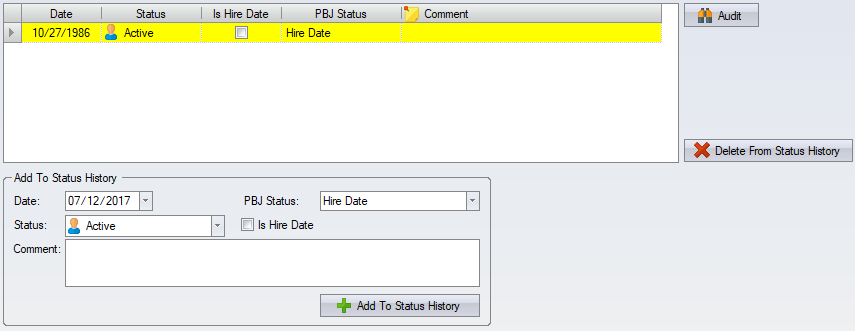Difference between revisions of "Employee Status"
From sbv.wiki
(Created page with "C:\SBV Software\Ta\help\Images\Home\Employee\Status\Tab.bmp Enter the employment history (hired, fired, leave of absence, etc.) in the Status tab. The sta...") |
|||
| (6 intermediate revisions by 2 users not shown) | |||
| Line 1: | Line 1: | ||
| − | |||
| − | + | [[image:EmployeeStatusTab.png]] | |
| − | + | The status information maintained here determines the employee's current status as displayed on the Main tab. The current status is highlighted in yellow. The software comes with Active and Inactive as the built-in status types. Additional status types can be added, e.g. LOA. | |
| − | + | [[image:EmployeeStatusTabPage.png]] | |
| − | + | * An employee with no status entries is considered Active but the software does not know the Hire Date, e.g. for seniority purposes. | |
| − | + | * Only changes in the employee's status should be entered. For example, an employee changing from a part timer to a full timer is NOT a status change. Previously entered statuses cannot be edited to encourage the maintenance of employee status history. The Is Hire Date is the only edit available on an existing status entry. | |
| + | |||
| + | * The software has a setting to determine if the first or last Active status entry should be considered the Hire Date. The default settings is that the latest Active status entry is used as the Hire Date. | ||
| + | |||
| + | * Adding an Inactive status entry will not make the employee's current status immediately inactive. The general rule is that an employee becomes Inactive once the pay period they became inactive in is prior to the previous pay period. | ||
| + | |||
| + | <noinclude>== See also == | ||
| + | |||
| + | * [[Employee]]</noinclude> | ||
Latest revision as of 17:33, 4 July 2019
The status information maintained here determines the employee's current status as displayed on the Main tab. The current status is highlighted in yellow. The software comes with Active and Inactive as the built-in status types. Additional status types can be added, e.g. LOA.
- An employee with no status entries is considered Active but the software does not know the Hire Date, e.g. for seniority purposes.
- Only changes in the employee's status should be entered. For example, an employee changing from a part timer to a full timer is NOT a status change. Previously entered statuses cannot be edited to encourage the maintenance of employee status history. The Is Hire Date is the only edit available on an existing status entry.
- The software has a setting to determine if the first or last Active status entry should be considered the Hire Date. The default settings is that the latest Active status entry is used as the Hire Date.
- Adding an Inactive status entry will not make the employee's current status immediately inactive. The general rule is that an employee becomes Inactive once the pay period they became inactive in is prior to the previous pay period.
